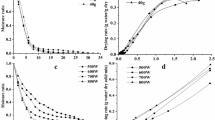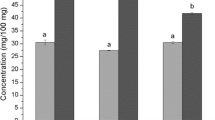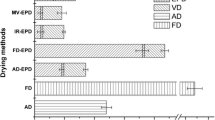Abstract
Citrus ‘Hallabong’ powders were prepared using hot air and freeze drying methods, and their physicochemical and flow properties were measured. The yields of the powders from whole fruit and pressed cake by hot air drying method were 17.5 and 22.0%, while those by freeze drying method were 20.0 and 22.5%, respectively. Vitamin C was high in freeze-dried whole fruit powders (220.8–364.7 mg/100 g) compared with those in hot air-dried ones (80.1–114.6 mg/100 g). Browning index of freeze-dried powders was significantly lower than those of hot air-dried ones. Bulk densities, compaction densities, and Hausner ratios of the powders were significantly higher in freeze drying method compared with hot air drying method. Water solubilities and hygroscopicities of freeze-dried powders were higher than those of hot air-dried ones. In conclusion, ‘Hallabong’ powders can be made using freeze drying method with high quality in terms of vitamin C content, color, and water solubility.
Similar content being viewed by others
References
Song HS, Park YH, Moon DG. Volatile flavor properties of ‘Hallabong’ grown in open field and green house by GC/GC-MS and sensory evaluation. J. Korean Soc. Food Sci. Nutr. 34: 1239–1245 (2005)
Kim HS, Lee SH, Koh JS. Physicochemical properties of ‘Hallabong’ tangor (Citrus Kiyomi×ponkan) cultivated with heating. Korean J. Food Preserv. 1 13: 611–615 (2006)
Lee SH, Kim HS, Koh JS. Quality changes of ‘Hallabong’ tangor (Citrus Kiyomi × ponkan) cultivated with heating during room temperature. Subtropical Agric. Biotech. Jeju National University, Korea 23: 1–6 (2007)
Garau MC, Simal S, Femenia A, Rossello C. Drying of orange skin: Drying kinetics modelling and functional properties. J. Food Eng. 75: 288–295 (2006)
Ratti C. Hot air and freeze drying of high-value foods: A review. J. Food Eng. 49: 311–319 (2001)
Schubert H. Food particle technology. Part I: Properties of particles and particulate food systems. J. Food Eng. 6: 1–32 (1987)
Peleg M. Physical characteristics of food powders. pp. 293–323. In: Physical Properties of Foods. The AVI Publishing Company Inc., Westport, CT, USA (1983)
Ko JW, Lee WY, Lee JH, Ha YS, Lee YH. Absorption characteristics of dried shiitake mushroom powder using different drying methods. Korean J. Food Sci. Technol. 31: 128–137 (1999)
Kim HR, Seog EJ, Lee JH, Rhim JW. Physicochemical properties of onion powder as influenced by drying methods. J. Korean Soc. Food Sci. Nutr. 36: 342–347 (2007)
AOAC. Official Method of Analysis of AOAC Intl. 16th ed. Method 934. 06, 942.15. Association of Official Analytical Chemists, Arlington, VA, USA (1995)
Rizzolo A, Formi E, Polesello A. HPLC assay of ascorbic acid in fresh and processed fruit and vegetables. Food Chem. 14: 189–199 (1984)
Albrecht JA, Schaffer HW, Zottola EA. Relationship of total sulphur to initial and retained ascorbic acid in selected cruciferous and noncruciferous vegetables. J. Food Sci. 55: 181–183 (1990)
ASTM Committee. Method D-1925-70, D-1729-627, D-1925-70, D-1729-607, America Society for Testing & Materials, Philadelphia, PA, USA (1975)
Kim HJ, Lee JH. Physicochemical properties of Salicornia herbacea powder as influenced by drying methods. Food Eng. Prog. 13: 105–109 (2009)
Shin EJ. Quality characteristics of Bulensia sarmienti powder through spray drying process. MS thesis, Kyungpook National University, Deagu, Korea (2009)
Dubois M, Giles KA, Hamilton JK, Rebers PA, Smith F. Colorimetric method for determination of sugars and relative substances. Anal. Chem. 28: 350–356 (1956)
Leach HW, McCowen LD, Schoh T. Structure of starch granules 1. Swelling and solubility patterns of various starches. Cereal Chem. 36: 534–544 (1959)
Chung HS, Hong JH, Youn KS. Quality characteristics of granules prepared by protein-bound polysaccharide isolated from Agaricus Blazei and selected forming agents. Korean J. Food Preserv. 12: 247–251 (2005)
Sosa N, Salvatori DM, Schebor C. Physico-chemical and mechanical properties of apple disks subjected to osmotic dehydration and different drying methods. Food Bioprocess Tech. DOI 10.1007/s11947-010-0468-4 (2010)
Kayaa A, Aydina O, Kolayl S. Effect of different drying conditions on the vitamin C (ascorbic acid) content of Hayward kiwifruits (Actinidia deliciosa Planch). Food Bioprod. Process. 88: 165–173 (2010)
Erenturk S, Gulaboglu MS, Gultekin S. The effects of cutting and drying medium on the vitamin C content of rosehip during drying. J. Food Eng. 68: 513–518 (2005)
Castaner M, Gil MI, Ruiz MV, Artes F. Browning susceptibility of minimally processed baby and romaine lettuces. Eur. Food Res. Technol. 209: 52–56 (1999)
Chung HS, Seong JH, Lee YG, Kim HS, Lee JB, Youn KS. Browning and moisture sorption characteristics of Rubus coreanus prepared by different drying methods. Korean J. Food Preserv. 16: 797–803 (2009)
Wang Y, Li D, Wang LJ, Li SJ, Adhikari B. Effects of drying methods on the functional properties of flaxseed gum powders. Carbohyd. Polym. 81: 123–133 (2010)
Lee WY, Kim JK. Absorption characteristics of persimmon powder depending on temperature changes and drying methods. J. East Asian Soc. Dietary Life 11: 479–484 (2001)
Lam PS, Sokansanj S, Bi X, Lim CJ, Naimi, Hoque M, Mani S, Womac AR, Ye XP, Narayan S. Bulk density of wet and dry wheat straw and switchgrass particles. Appl. Eng. Agric. 24: 351–358 (2008)
Littlefield B, Fasina OO, Shaw J, Adhikari A, Via B. Physical and flow properties of pecan shells-particle size and moisture effects. Powder Technol. 212: 173–180 (2011)
Lee SC, Chang KS, Park YD, Kang HA. Effect of drying method on rheological properties of milk powders. J. Korean Agric. Chem. 36: 416–423 (1993)
Abdullah EC, Geldart D. The use of bulk density measurements as flowability indicators. Powder Technol. 102: 151–165 (1999)
Kim HS, Han MR, Chang MJ, Kim MH. Study of browning and caking reduction techniques in onion powder. Food Eng. Prog. 12: 269–274 (2008)
Lee MJ, Seog EJ, Lee JH. Physicochemical properties of chaga (Inonotus obliquus) mushroom powder as influenced by drying methods. J. Food Sci. Nutr. 12: 40–45 (2007)
Tsami E, Krokida MK, Drouzas AE. Effect of drying method on the sorption characteristics of model fruit products. J. Food Eng. 38: 381–392 (1999)
Kim DW, Chang KS, Lee UH, Kim SS. Moisture sorption characteristics of model food powders. Korean J. Food Sci. Technol. 28: 1146–1150 (1996)
Kim DW. The study of fluid and absorption properties for model powder food. PhD thesis, Chungnam National University, Daejeon, Korea (1992)
Author information
Authors and Affiliations
Corresponding author
Rights and permissions
About this article
Cite this article
Lee, CW., Oh, HJ., Han, SH. et al. Effects of hot air and freeze drying methods on physicochemical properties of citrus ‘hallabong’ powders. Food Sci Biotechnol 21, 1633–1639 (2012). https://doi.org/10.1007/s10068-012-0217-8
Received:
Revised:
Accepted:
Published:
Issue Date:
DOI: https://doi.org/10.1007/s10068-012-0217-8




